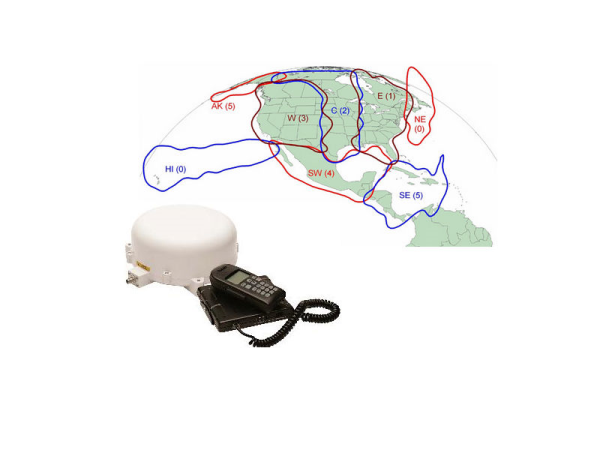On many vessels in this day and age communication in offshore waters is essential to the smooth function of the ship. The Oceana 800 helps simplify this ease of remote communications by providing a efficient, fast, easy way to communicate via satellite an all-in-one IP54 maritime interface. It’s adaptable to take anywhere from two to five corded/cordless phone or integration into a PABX system which also includes built-in intelligence to support standard ring, busy, and dial tones via an intelligent RJ11/POT interface. The Oceana 800 provides options for Bluetooth capabilities, as well as a full color LCD screen for easy viewing of information such as phone numbers stored on the device. The system includes up to 2000ft of cabling so placing it on hard to reach places such as lower decks isn’t a problem. Ease of installation means that even the least technically savvy individual can install this system.
This satellite phone comes equipped with a internal SIM for easy storage of phone numbers and SMS messages as well as a secondary SIM socket for easy transfer of information that overrides the internal memory. It also includes such amenities such as hands-free speaker phone, wall-mounting, USB data ports, and a privacy handset. This phone is aimed at larger vessels such as cargo haulers or pleasure ships but even in the smallest fishing ship could find it’s use invaluable. This all-in-on system operates with Inmarsat “Fleetphone” telephony service that includes a dedicated marine class antenna system for instant use at anytime.
Fleet calls are as low as 55 cents per minute which incorporate 505 emergency calling, a complete set location tracking information as well as periodic location messaging (including heading, speed, and speed) with the ability to send and receive e-mails via the LCD screen by using an intergrated GPS engine system. The system helps provide crews with an additional safety net when operating on the high seas by allowing communication with emergency services when out of the range of terrestrial services such as land-based cellular towers that provides an unprecedented reliability in ship-based communications that can save your life in the event of an emergency.
Overall this phone provides excellent value (only retailing 2,300 USD)for a wide-range of applications and uses. From the smallest tug to the largest freighter the Oceana 800 has a place and use on any vessel with value that’s pretty unprecedented in phones of it’s class.

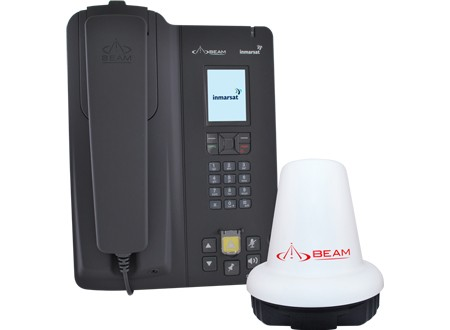
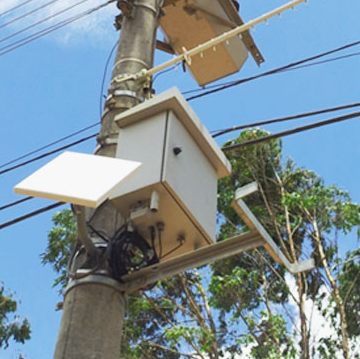
 The BGAN 9502 Satellite SCADA terminal is ideal for applications in environmental monitoring, video surveillance, Smart Meter, pipeline monitoring, compressor monitoring and any other projects which involve communication with remote assets. This terminal is power consumption friendly as it only draws 3 – 4 watts for an always open TCP-IP network connection. In idle or hibernation mode the terminal’s power consumption can be as low as 0.01 watts. Given that most of these applications are located in remote locations, power consumption is a major priority. With this model, it is easy to use solar power which can be installed at a very low cost to power the device.
The BGAN 9502 Satellite SCADA terminal is ideal for applications in environmental monitoring, video surveillance, Smart Meter, pipeline monitoring, compressor monitoring and any other projects which involve communication with remote assets. This terminal is power consumption friendly as it only draws 3 – 4 watts for an always open TCP-IP network connection. In idle or hibernation mode the terminal’s power consumption can be as low as 0.01 watts. Given that most of these applications are located in remote locations, power consumption is a major priority. With this model, it is easy to use solar power which can be installed at a very low cost to power the device.
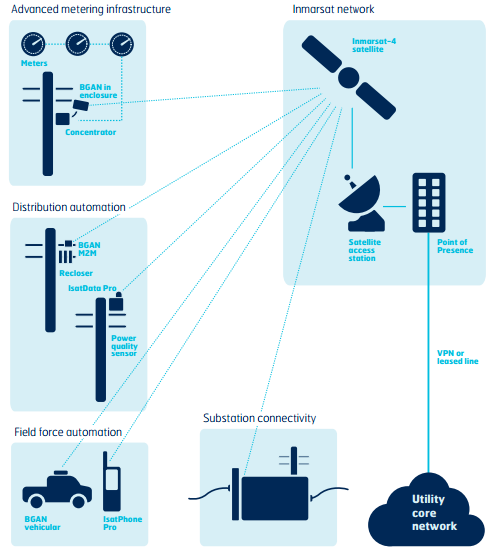

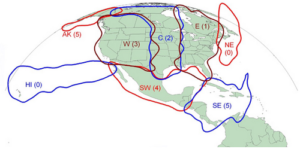 The network of this geostantionary satellite covers North American and tip of Central America, the Caribbean, Hawaii, and coastal waters. While users of terrestrial land mobile radios have to depend on the coverage of cell towers, satellite dispatch radio users rarely experience service interruptions because of the singular network structure. During emergencies, should terrestrial land based communications become compromised, satellites are the only viable option for communications.
The network of this geostantionary satellite covers North American and tip of Central America, the Caribbean, Hawaii, and coastal waters. While users of terrestrial land mobile radios have to depend on the coverage of cell towers, satellite dispatch radio users rarely experience service interruptions because of the singular network structure. During emergencies, should terrestrial land based communications become compromised, satellites are the only viable option for communications.
 The MSAT-G2 push to talk radio communicates with the lightsquared satellite network and provides push to talk and PSTN voice services for all of North America and the northern portion of South American and the Carribean. The MSAT-G2 is both lightweight and practical, as it can be installed in vehicles, buildings, or put together as a “Go-Kit” for portable satellite communications. The “Go-Kit” comes in a water-resistant durable package that also comes with a battery that delivers power when on the go.
The MSAT-G2 push to talk radio communicates with the lightsquared satellite network and provides push to talk and PSTN voice services for all of North America and the northern portion of South American and the Carribean. The MSAT-G2 is both lightweight and practical, as it can be installed in vehicles, buildings, or put together as a “Go-Kit” for portable satellite communications. The “Go-Kit” comes in a water-resistant durable package that also comes with a battery that delivers power when on the go. Many different off the shelf interoperability modules and vehicular repeaters are compatibleMSAT G2 Satellite Radio with the MSAT-G2. It is possible to have interoperation between the MSAT-G2 and multiple different models and brands of wireless phones and radios with Push to talk capability using the interoperability modules. The range of the MSAT-G2 installed in a vehicle can be extended using vehicle repeaters. That set-up allows public safety workers to maintain connectivity in a car that has an LMR portable radio. The vehicle then works as the satellite repeater, allowing him to continue communications.
Many different off the shelf interoperability modules and vehicular repeaters are compatibleMSAT G2 Satellite Radio with the MSAT-G2. It is possible to have interoperation between the MSAT-G2 and multiple different models and brands of wireless phones and radios with Push to talk capability using the interoperability modules. The range of the MSAT-G2 installed in a vehicle can be extended using vehicle repeaters. That set-up allows public safety workers to maintain connectivity in a car that has an LMR portable radio. The vehicle then works as the satellite repeater, allowing him to continue communications. Lightsquared uses a “trunking” concept in their push-to-talk service that allows many different users to share a group of channels with the simple press of the PTT button. The network is designed to be as effective as possible despite having limited satellite power and bandwidth. Satellite power and call-handling resources are managed using demand assigned communication channels. “Call types” are also employed in the network to achieve the same results. When PSTN and cellular network congestion becomes a problem, Lightsquared’s group oriented communications take care of the issue by allowing large numbers to communicate on a single set of frequencies without ever using PSTN. A pre-defined period of activity defines when a frequency will be released.
Lightsquared uses a “trunking” concept in their push-to-talk service that allows many different users to share a group of channels with the simple press of the PTT button. The network is designed to be as effective as possible despite having limited satellite power and bandwidth. Satellite power and call-handling resources are managed using demand assigned communication channels. “Call types” are also employed in the network to achieve the same results. When PSTN and cellular network congestion becomes a problem, Lightsquared’s group oriented communications take care of the issue by allowing large numbers to communicate on a single set of frequencies without ever using PSTN. A pre-defined period of activity defines when a frequency will be released.
 Crabbers are the men, and sometimes women, that take to the frigid waters north of 60 for a few weeks at a time in search of Alaskan king crab. This is considered by many to be the most dangerous job out there, with 20+ hour work shifts and an unforgiving sea some of the issues they have to face. Combine that with sub-zero temperatures and 40-foot waves and you have a recipe for extreme danger. It seems strange to most of us that people would put their lives at risk in order to put a delicious crab on our plates, but crabbers see the potential rewards as well worth the risk.
Crabbers are the men, and sometimes women, that take to the frigid waters north of 60 for a few weeks at a time in search of Alaskan king crab. This is considered by many to be the most dangerous job out there, with 20+ hour work shifts and an unforgiving sea some of the issues they have to face. Combine that with sub-zero temperatures and 40-foot waves and you have a recipe for extreme danger. It seems strange to most of us that people would put their lives at risk in order to put a delicious crab on our plates, but crabbers see the potential rewards as well worth the risk.
 By being able to deliver almost 37 times as much data as the competition, IsatData Pro has the ability toisatdata pro satellite m2m meet the increasing demand for richer information in the service. Businesses are now able to diversify their operations and share more via e-mail, electronic forms, remote management and more. The applications delivered by this M2M Satellite service include the maintenance of driver logs, text messaging remote workers, vehicle telemetry information, and the control and management of fixed assets.
By being able to deliver almost 37 times as much data as the competition, IsatData Pro has the ability toisatdata pro satellite m2m meet the increasing demand for richer information in the service. Businesses are now able to diversify their operations and share more via e-mail, electronic forms, remote management and more. The applications delivered by this M2M Satellite service include the maintenance of driver logs, text messaging remote workers, vehicle telemetry information, and the control and management of fixed assets.